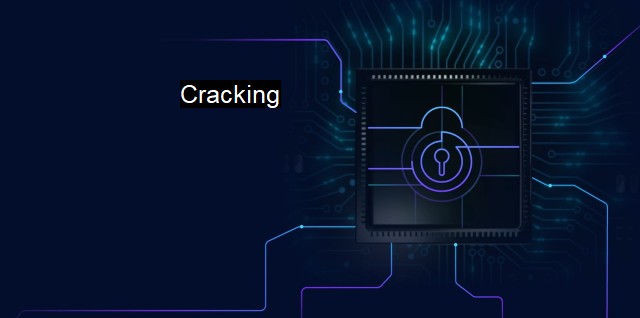What is Cracking?
Cracking the Code: Understanding the Types of Cybersecurity Attacks and Their Impact on Networks
Cracking, within the context of cybersecurity and antivirus systems, refers to the dubious practice of either attempting to or successfully bypassing the functions of a programmed protection adopted by digital systems. The most common form of cracking incorporates breaking tightly woven algorithms and codes that restrict a user's unauthorized access to a software or account - this could be for purposes such as breaking password-protected systems, unauthorized downloads of protected software or media, or manipulation of performance attributes.Cracking exploits the weak points in systems so as to manipulate or override the software code to ultimately change the system's primary functions. Crackers often succeed by locating and manipulating the code that initiates the software's protective systems. This can involve anything from simple commands within the software's command line, to complex programming and reprogramming of the software’s protective shields.
Cracking usually tends to have a negative connotation, being linked with illegal activities. This is primarily due to the potential for misuse of access gained after having cracked a code not intended for general entry. Misuse of cracked access may involve activities such as illicit access to personal accounts, breach of privacy, theft of data and intellectual property, and even sabotage of entire digital systems. This raises substantial security concerns, as crackers may potentially inflict severe damage both on an individual level as well as on a macro level, targeting large corporations or even states.
Despite the common negative correlation, cracking is not always viewed as a malicious act. Some versions of cracking involve ethical hacking in which, an authorised professional intentionally hacks into a system to identify vulnerabilities and then help mend them. Ethical hacking is vital for progressive development and maintenance of rock-solid security systems.
In compliance with the thriving digital era, cybersecurity systems have become paramount. One such crucial system is the antivirus software which aids in safeguarding against malicious threats, such as viruses, trojans or worms. These antivirus systems use databases of known malicious code to routinely scan systems and identify potential threats. While the level of security achieved depends on the sophistication of the antivirus used, it still raises questions about the security of such systems.
In the hands of a skilled cracker, these antivirus systems can be cracked and rendered useless. Crackers may inject manipulated codes into systems to infect and break them. Since the inception of internet connectivity, cracks have become rampant and thus, ensuring the robustness of antivirus systems against vulnerabilities is fundamental. Crackers continue to be a looming threat as they constantly evolve and become more advanced, finding new ways to bypass the antivirus systems.
Drivin by the continued advancement in technology, cracking is an evolving concern for cybersecurity experts. The trend presents a widening gap in security that needs urgent attention. While cracking has potential use in improving security through ethical hacking, more commonly it has become a tool for manipulating antivirus systems to execute malicious operations. Currently, strengthening the security of digital systems, including antivirus software, and managing the negative implications of cracking, remains a priority for cyber experts to the end of buttressing the defenses of our virtual world.

Cracking FAQs
What is cracking in the context of cybersecurity?
Cracking is the act of bypassing security measures in computer systems to gain unauthorized access or to cause harm. It can involve techniques such as password guessing, exploiting vulnerabilities, and social engineering.How does antivirus software help prevent cracking?
Antivirus software uses various methods to detect and block malware, including signature-based detection, behavioral analysis, and heuristics. By scanning files and programs for known threats and suspicious behavior, antivirus software can help prevent cracking attacks that rely on malware.What are some common types of cracking attacks?
Some common types of cracking attacks include password cracking, SQL injection, buffer overflow attacks, and distributed denial-of-service (DDoS) attacks. These attacks can be carried out by cybercriminals or hackers seeking to steal sensitive data or cause disruption to computer systems.What steps can I take to protect my computer from cracking attacks?
To protect your computer from cracking attacks, you should use strong passwords, keep your software and operating system up to date with security patches, use antivirus software, and be cautious when opening email attachments or downloading files from the internet. It's also important to practice good cybersecurity hygiene, such as not sharing personal information online and avoiding clicking on suspicious links.Related Topics
Password cracking Reverse engineering Malware analysis Penetration testing Vulnerability scanning
| | A | | | B | | | C | | | D | | | E | | | F | | | G | | | H | | | I | | | J | | | K | | | L | | | M | |
| | N | | | O | | | P | | | Q | | | R | | | S | | | T | | | U | | | V | | | W | | | X | | | Y | | | Z | |
| | 1 | | | 2 | | | 3 | | | 4 | | | 7 | | | 8 | | |||||||